AddingUMIACSCertificateAuthority: Difference between revisions
Jump to navigation
Jump to search
| Line 24: | Line 24: | ||
* Visit http://intranet.umiacs.umd.edu | * Visit http://intranet.umiacs.umd.edu | ||
* Scroll to the bottom and click "UMIACS CA Root Certificate (CRT - Most Browsers)". Download and open this file by double-clicking it<br />[[Image:UMIACSCA_IE_1.png|border]] | * Scroll to the bottom and click "UMIACS CA Root Certificate (CRT - Most Browsers)". Download and open this file by double-clicking it<br />[[Image:UMIACSCA_IE_1.png|border]] | ||
* Select ok to add the certificate to your keychain:<br />[[Image:OSX_1.png| | * Select ok to add the certificate to your keychain:<br />[[Image:OSX_1.png|600px]] | ||
* The previous step will add the certificate for your own account. However, OSX will preemptively ask if you'd like to add it for the whole system. If you have administrative access on your Mac, choose Always Trust:<br />[[Image:OSX_2.png| | * The previous step will add the certificate for your own account. However, OSX will preemptively ask if you'd like to add it for the whole system. If you have administrative access on your Mac, choose Always Trust:<br />[[Image:OSX_2.png|600px]] | ||
* Enter the administrator credentials to add this certificate for all users of the system:<br />[[Image:OSX_3.png| | * Enter the administrator credentials to add this certificate for all users of the system:<br />[[Image:OSX_3.png|600px]] | ||
* Close the keychain access window. | * Close the keychain access window. | ||
Revision as of 18:16, 28 July 2010
Introduction
When you visit some webpages encrypted with SSL, you may be presented with a warning about the site's security certificate not being trusted. These are normally important screens to pay attention to, but UMIACS goes to great lengths to maintain a secure environment for our users. We provide a UMIACS CA (certificate authority) that enables your web browser to trust our secure webpages. The following steps explain how to import this certificate.
Internet Explorer and Google Chrome (Windows)
- Visit http://intranet.umiacs.umd.edu
- Scroll to the bottom and click "UMIACS CA Root Certificate (CRT - Most Browsers)". Download and open this file
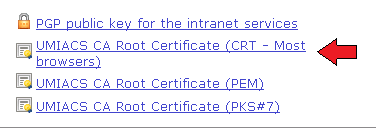
- Click "Install Certificate..." towards the bottom of the dialog box
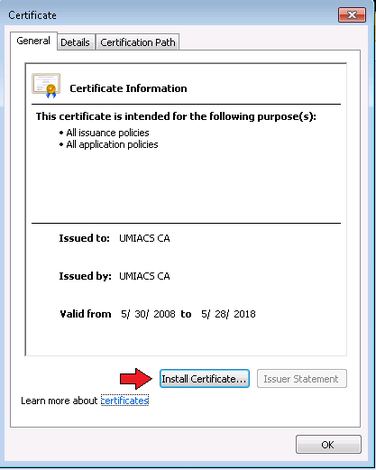
- Click Next
- Choose "Place all certificates in the following store"
- Choose "Trusted Root Certification Authorities" and click ok
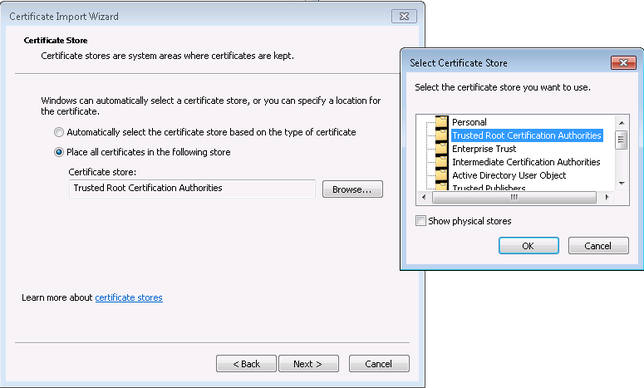
- Click next and then finished. You should receive a success message similar to the following:
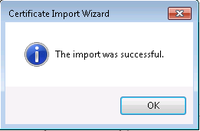
Firefox (cross-platform)
- Visit http://intranet.umiacs.umd.edu
- Scroll to the bottom and click "UMIACS CA Root Certificate (CRT - Most Browsers)".

Firefox should open a "Downloading Certificate" dialog box automatically. It may look slightly different than this depending on your operating system: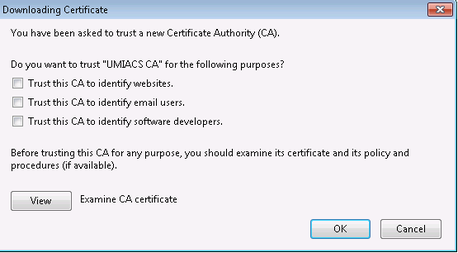
- Check all three boxes indicating that you fully trust this Certificate Authority
- Click ok.
Safari (Mac OSX)
- Visit http://intranet.umiacs.umd.edu
- Scroll to the bottom and click "UMIACS CA Root Certificate (CRT - Most Browsers)". Download and open this file by double-clicking it

- Select ok to add the certificate to your keychain:
File:OSX 1.png - The previous step will add the certificate for your own account. However, OSX will preemptively ask if you'd like to add it for the whole system. If you have administrative access on your Mac, choose Always Trust:
File:OSX 2.png - Enter the administrator credentials to add this certificate for all users of the system:
File:OSX 3.png - Close the keychain access window.
Other Browsers (Linux)
Due low level differences of Linux, accepting the root certificate at the operating system level is nontrivial. If you need assistance accepting the certificate for any other browser, please contact UMIACS Staff.